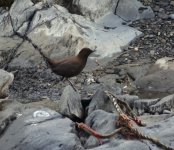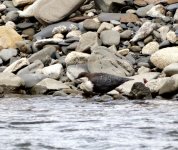-
Welcome to BirdForum, the internet's largest birding community with thousands of members from all over the world. The forums are dedicated to wild birds, birding, binoculars and equipment and all that goes with it.
Please register for an account to take part in the discussions in the forum, post your pictures in the gallery and more.
You are using an out of date browser. It may not display this or other websites correctly.
You should upgrade or use an alternative browser.
You should upgrade or use an alternative browser.
White-throated Dipper (1 Viewer)
- Thread starter Daniel Philippe
- Start date
More options
Who Replied?Richard Klim
-------------------------
Could someone with access please summarise the conclusions.
Richard
Richard
Xenospiza
Distracted
White-throated (cinclus) and Brown Dipper (pallasii) got separated 2.5 million years ago (even this is shorter than e.g. Western Palearctic and Afrotropical Thekla Larks – see Van Steenis in the most recent Dutch Birding).
There are a number of lineages within cinclus.
Asian birds (e.g. leucogaster from Kazakhstan and przewalski from Siberia) are "distantly" related to western birds, but even this separation is only 250,000 y old (similar to e.g. Sicilian Rock Partridge and Rock Partridge). I'd be willing to accept this as a split, if only because I've seen White-bellied Dipper in KZ, hahaha.
Ssp aquaticus consists of an Eastern and Western European clade (which includes hibernicus) (the article seems to include Spanish and Corsican birds in cinclus, which is a novelty to me – they belong to the western clade): these split 120,000 y ago. There is a contact zone from Luxemburg to Hungary.
Northern (cinclus and uralicus), Moroccan (minor), Corsican (ssp?) and Caucasian (caucasicus) birds are all even more recent lineages (~ 50,000 y old): I certainly wouldn't want to go as far as to treat all these as "species" (that would honestly be ridiculous), although some new clade names might be necessary to separate the Central European dippers.
There are a number of lineages within cinclus.
Asian birds (e.g. leucogaster from Kazakhstan and przewalski from Siberia) are "distantly" related to western birds, but even this separation is only 250,000 y old (similar to e.g. Sicilian Rock Partridge and Rock Partridge). I'd be willing to accept this as a split, if only because I've seen White-bellied Dipper in KZ, hahaha.
Ssp aquaticus consists of an Eastern and Western European clade (which includes hibernicus) (the article seems to include Spanish and Corsican birds in cinclus, which is a novelty to me – they belong to the western clade): these split 120,000 y ago. There is a contact zone from Luxemburg to Hungary.
Northern (cinclus and uralicus), Moroccan (minor), Corsican (ssp?) and Caucasian (caucasicus) birds are all even more recent lineages (~ 50,000 y old): I certainly wouldn't want to go as far as to treat all these as "species" (that would honestly be ridiculous), although some new clade names might be necessary to separate the Central European dippers.
Richard Klim
-------------------------
Xenospiza, many thanks.
Richard
Richard
Richard Klim
-------------------------
...the article seems to include Spanish and Corsican birds in cinclus, which is a novelty to me...
BWP noted that populations from western & central France, the Pyrenees, Sardinia and Corsica are "close to nominate cinclus and (for simplicity) included in it", and "populations from north-west Iberia also included in nominate cinclus". This curious arrangement, with allopatric populations of cinclus to the north and south of aquaticus, is also followed by Brewer 2001 (Wrens, Dippers & Thrashers) and by Dickinson 2003 (H&M3). But Clements 2007 seems to include all southern European populations within aquaticus.
Richard
Last edited:
Acrocephalus
Well-known member

Richard Klim
-------------------------
Subspecies
Richard
The definition of Dipper subspecies certainly seems to be a mess, in continental Europe anyway, with aquaticus (at least) perhaps better treated as a colour morph of nominate cinclus...?Campos F. et al. (2010). The White-throated Dipper Cinclus cinclus subspecies in Spain. Ringing & Migration 25: 3–6.
Richard
Peter Kovalik
Well-known member

It seems this paper is not mentioned on BF:
M. Ángeles HERNÁNDEZ, Francisco CAMPOS, Tomás SANTAMARÍA, Luis CORRALES, M. Ángeles ROJO and Susana DIAS. Genetic differences among iberian white-throated dipper Cinclus cinclus populations based on the cytocrome b sequence. Ardeola 59(1), 2012, 111-122.
[Abstract]
M. Ángeles HERNÁNDEZ, Francisco CAMPOS, Tomás SANTAMARÍA, Luis CORRALES, M. Ángeles ROJO and Susana DIAS. Genetic differences among iberian white-throated dipper Cinclus cinclus populations based on the cytocrome b sequence. Ardeola 59(1), 2012, 111-122.
[Abstract]
Daniel Philippe
Well-known member
M. Ángeles HERNÁNDEZ, Francisco CAMPOS, Tomás SANTAMARÍA, Luis CORRALES, M. Ángeles ROJO and Susana DIAS. Genetic differences among iberian white-throated dipper Cinclus cinclus populations based on the cytocrome b sequence. Ardeola 59(1), 2012, 111-122.
[Abstract]
Thanks Peter, PDF from this page . Scroll down a bit.
Richard Klim
-------------------------
Hourlay, Libois, D'Amico, Sarà, O'Halloran & Michaux 2008. Evidence of a highly complex phylogeographic structure on a specialist river bird species, the dipper (Cinclus cinclus). Mol Phylogenet Evol 49(2): 435–444. [pdf]It seems that its taxonomic status needs a revision: http://dx.doi.org/10.1016/j.ympev.2008.07.025
OrientalBirding, 11 Dec 2014...
Ormerod & Tyler 2005 (HBW 10):request: Dippers: cinclus & pallasii
Dear All
Professor Jochen Martens (Professor Emeritus at Mainz Uni) ([email protected]) has asked whether anyone could assist with this mystery. The question was initially posed to OSME members but the the vast majority of brown dippers' breeding distribution is in the OBC region.
"I want to draw your attention to one open point to which OSME observers may contribute. In a large ongoing project on Sino-Tibetan passerines we found that our (few) samples of high-altitude Brown Dippers Cinclus pallasii from China actually all belong to White-throated C. cinclus. This was the case up to 4000 m, and we observed even a "mixed" pair at that height. There is a possibility that (all?) high-altitude pallasii might in reality be brown/dark cinclus. Perhaps OSME observers might contribute to this question by the collection of genetic samples (blood, muscle, even single feathers may do)." [Original text slightly edited]
Please address any offers of help to Jochen.
Dave Buckingham
Brewer 2001 (Wrens, Dippers and Thrashers)...
Although C pallasii occurs at lower altitudes than C cinclus in China and the Himalayas, the reverse is true in the Tien Shan in Kazakhstan...Brown Dipper Cinclus pallasii
... In extreme parts of its range in Central Asia it is sympatric with Eurasian Dipper. It has been stated (Meyer & Schauensee 1984) that there is an altitudinal separation between the species, the Brown Dipper occurring lower down. However, this is certainly not invariable; in one stream in Uzbekistan the nests of the two species alternated along a length of stream (Kashkarov et al. 1995).
Wassink (the Birds of Kazakhstan):
Last edited:
MJB
Well-known member
Richard,
Thanks for publicising Dave Buckingham's request - he beat me to it and congratulations to him on his speedy response! I had just compiled a near-identical request on behalf of OSME - I had been in correspondence with Jochen Martens on other taxonomic matters, when he made this request. I passed it on to OSME Chairman who then contacted OBC.
Here's hoping that someone reading the appeal will be able to obtain some data that might help explain the conundrum.
MJB
Thanks for publicising Dave Buckingham's request - he beat me to it and congratulations to him on his speedy response! I had just compiled a near-identical request on behalf of OSME - I had been in correspondence with Jochen Martens on other taxonomic matters, when he made this request. I passed it on to OSME Chairman who then contacted OBC.
Here's hoping that someone reading the appeal will be able to obtain some data that might help explain the conundrum.
MJB
Last edited:
Ian Lewis
aka Gryllo

Richard,
Here's hoping that someone reading the appeal will be able to obtain some data that might help explain the conundrum.
MJB
From my notes of a trip I did to Tibet with Jesper Hornskof
'From the Bayan Kala pass we dropped down a long valley to the town of Yushu ....... and I was interested to find that near here where the range of the familiar White-throated Dipper abuts that of (the lower altitude) Brown Dipper, a brown-throated form occurs that looks like Brown Dipper but has the measurements of White-throated. Indeed we saw a brown-throated and white-throated pair of White-throated Dippers feeding a juvenile'
As far as I can remember, the throat of this variant is a paler brown than the rest of the plumage but covers the same area as the white throat of a regular White-throated Dipper.
Ian
Sangahyando
Well-known member

Im not sure how to interpret this passage. If 4000m is the upper limit of brown-looking-but-actually-white-throated dippers (which is what I assume they're saying), what's the lower limit at?This was the case up to 4000 m, and we observed even a "mixed" pair at that height.
Point in case, I saw one or two brown (lower case, now that their ethnicity is in doubt) Dippers in Jiuzhaigou (Sichuan), at about 2000m (entrance to the park) a few years ago. Unfortunately, I lost my notes, but I don't recall a paler brown throat as described by Ian Lewis. So which species would they most likely belong to? McKinnon's guide says that the lowest altitude for White-throated Dipper is 2400m, but in light of the new information in this thread I'm wondering if that's still accurate.
Jens Thalund
Well-known member
On a visit to Sichuan last month, I spent a couple of days around Tagong on the SE part of the highlands, at around 3750 m asl, and recorded both White-throated and Brown Dipper on the same rivers. The two Brown Dippers were actually the ones I recorded highest up (but by no more than 5-10 m asl!), and seemed to be a pair, which disappeared together behind a tree-root overhanging the river (nest-prospecting?).
On the same river I also recorded a single Common Kingfisher, a migrant no doubt, but quite high up as it is listed as a breeding bird below 1500 m asl in the China guide book.
On the same river I also recorded a single Common Kingfisher, a migrant no doubt, but quite high up as it is listed as a breeding bird below 1500 m asl in the China guide book.
Attachments
Richard Klim
-------------------------
Users who are viewing this thread
Total: 2 (members: 0, guests: 2)





